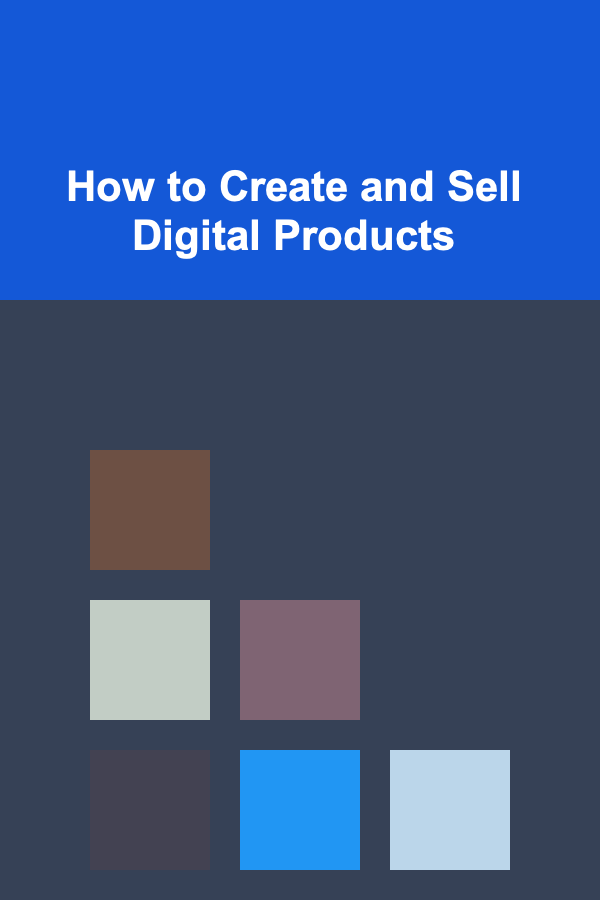
How to Create and Sell Digital Products
ebook include PDF & Audio bundle (Micro Guide)
$12.99$8.99
Limited Time Offer! Order within the next:

The rise of the internet and digital technologies has revolutionized the way we do business. One of the most profitable opportunities in today's digital landscape is the creation and sale of digital products. Whether you're an artist, a designer, a developer, or someone with expertise in a particular field, digital products provide a platform to reach a global audience and generate revenue. In this article, we will explore how to create and sell digital products, providing you with practical steps, strategies, and insights to turn your ideas into profitable ventures.
Understanding Digital Products
Before diving into how to create and sell digital products, it's important to understand what digital products are. A digital product is any product that exists in digital form and can be sold and distributed electronically. This includes everything from eBooks, software, online courses, digital art, stock photos, and music, to templates, fonts, and more.
Digital products are different from physical products in several key ways. For one, they have no manufacturing or shipping costs, and they can be sold repeatedly without the need for restocking. This makes them incredibly scalable and profitable once the initial creation process is complete.
Why Create Digital Products?
There are several compelling reasons to consider creating digital products:
1. Low Overhead Costs
Creating digital products often involves minimal startup costs. If you already have the necessary software and skills, the investment is mostly your time and effort. There are no costs for materials, warehouses, or shipping, which means higher profit margins.
2. Passive Income
Once your digital product is created, it can be sold over and over without additional effort. This makes it a great source of passive income, allowing you to earn money while you sleep.
3. Global Market Reach
With digital products, there are no geographical restrictions. As long as you have an internet connection, you can sell to customers all over the world. This opens up an enormous potential market, whether you're selling an online course, an app, or a piece of digital art.
4. Flexibility
Creating and selling digital products gives you the flexibility to work from anywhere, at any time. This is especially appealing for those who want to pursue a side hustle or build a full-time online business.
5. Eco-Friendly
Since digital products do not require any physical materials or shipping, they are an eco-friendly option. This can be a selling point for customers who are environmentally conscious.
Step-by-Step Guide to Creating Digital Products
Step 1: Identify a Niche
The first step in creating a successful digital product is identifying a niche. A niche is a specific market segment that your product will serve. The more specific your niche, the better you can tailor your product to meet the needs of your target audience.
Here are a few ways to identify a profitable niche:
- Solve a Problem: Think about common problems people face in a particular area and create a product that solves that problem. For example, if you're an expert in fitness, you might create a digital workout program for busy professionals.
- Passion and Expertise: Create products based on your own passions and expertise. If you're passionate about photography, for instance, you could create a photography eBook or online course.
- Market Research: Conduct research to see what kinds of digital products are trending or in demand. Look at popular marketplaces like Etsy, Gumroad, or Udemy to see what kinds of products are selling well.
Step 2: Plan and Outline Your Product
Once you've identified your niche, the next step is to plan and outline your digital product. This will help you stay focused and organized as you create your product. You can break this process into several key steps:
- Determine the Type of Product: Will you create an eBook, an online course, a software tool, a digital art collection, or something else? The type of product will dictate the tools and resources you need.
- Outline the Content: For an eBook or online course, create an outline of the content you want to include. For software, map out the features and functionalities. The more detailed your outline, the easier it will be to stay on track.
- Set a Goal and Timeline: Define a clear goal for your product and set a timeline for completion. This will help you stay motivated and ensure that your project moves forward.
Step 3: Create the Product
Now comes the most crucial part: creating the digital product. Depending on the type of product, the process will vary. Below are some common types of digital products and tips for creating them:
eBooks
eBooks are one of the most popular types of digital products. They can cover virtually any topic and can be sold on platforms like Amazon Kindle, your website, or marketplaces like Gumroad. Here's how to create one:
- Write Your Content: Use your outline to write the content of your eBook. Focus on providing valuable, high-quality content that addresses your audience's needs.
- Design the Layout: Tools like Adobe InDesign or Canva can help you create an attractive layout for your eBook. You can also hire a designer to create a professional-looking eBook cover.
- Convert to PDF or ePub: Once your eBook is ready, convert it to a format that is easy for customers to download and read. PDF and ePub are the most common formats.
Online Courses
Online courses are another popular digital product, especially in fields like education, business, fitness, and technology. To create an online course:
- Choose a Platform: Platforms like Teachable, Thinkific, and Udemy allow you to create and sell courses. They provide tools to upload videos, quizzes, and other course materials.
- Create Video and Text Content: Record videos, write lesson scripts, and create supporting documents like slides, worksheets, or guides. Ensure that your content is engaging and well-structured.
- Engage with Your Audience: Offering quizzes, assignments, and interactive elements can help make your course more engaging and provide value to your students.
Digital Art or Graphic Design
If you're a designer, creating and selling digital art or design templates can be highly profitable. You can sell digital artwork, illustrations, social media templates, or printable planners. To create digital art:
- Use Design Tools: Programs like Adobe Illustrator, Photoshop, or Procreate are popular among designers. You can create high-quality art that can be sold as standalone products or as part of a collection.
- Offer Multiple Formats: Ensure your digital art is available in various formats (JPG, PNG, SVG, etc.) to cater to different customers' needs.
Software or Apps
Creating software or mobile apps requires technical expertise, but it can be one of the most profitable types of digital products. If you have programming skills, you can create tools that help solve specific problems or provide unique features. Here's how:
- Identify a Problem: The best software solves a problem. Identify a problem your target market faces and create software to address that need.
- Design the User Interface (UI): The user interface should be intuitive and user-friendly. Invest time in designing an attractive UI that enhances the user experience.
- Develop the Software: If you're not a developer, you may need to hire a developer to bring your vision to life. Alternatively, you can use no-code platforms to create simple apps without coding knowledge.
Step 4: Market Your Digital Product
Once your digital product is created, it's time to market and sell it. Marketing is key to ensuring that your product reaches its intended audience and generates sales. Here are some strategies to help you market your digital product:
1. Use Social Media
Platforms like Instagram, Facebook, and Twitter are powerful tools for promoting digital products. Share sneak peeks of your product, behind-the-scenes content, and customer testimonials to build excitement.
2. Content Marketing
Start a blog, podcast, or YouTube channel related to your niche. By providing valuable content, you can attract an audience that is interested in your product. Once you've built a loyal following, promote your digital product to them.
3. Email Marketing
Build an email list by offering free content (like a free eBook or course preview) in exchange for subscribers' contact information. Once you have a list, send out targeted emails to promote your products and offer special discounts.
4. Affiliate Marketing
Consider setting up an affiliate program where other marketers promote your product in exchange for a commission. This can help expand your reach and increase sales without upfront advertising costs.
5. Paid Ads
Using platforms like Google Ads or Facebook Ads can help you target specific audiences and generate sales. Be sure to use highly targeted ad campaigns to maximize your ad spend.
Step 5: Set Up a Sales Platform
The next step is setting up a platform where people can purchase your digital products. There are several ways to do this:
1. Your Own Website
Having your own website is the most professional way to sell digital products. You can use platforms like Shopify, WordPress with WooCommerce, or Wix to set up an e-commerce store.
2. Marketplaces
You can also list your products on third-party marketplaces like Etsy, Gumroad, or Udemy. These platforms have built-in audiences, which can help you generate sales without extensive marketing efforts.
Conclusion
Creating and selling digital products is an excellent way to build a scalable business with low overhead costs. By identifying a profitable niche, creating high-quality products, and employing effective marketing strategies, you can turn your digital products into a sustainable source of income. Whether you're creating eBooks, online courses, software, or digital art, the opportunities are vast, and the rewards can be significant. Take the time to research, plan, and execute your product creation and marketing strategies, and you'll be well on your way to success in the digital marketplace.
Reading More From Our Other Websites
- [Hiking with Kids Tip 101] Top 10 Kid-Friendly Hikes for Family Adventures in Every Season
- [Toy Making Tip 101] Sustainable Play: Crafting Eco-Friendly Toys as a Creative Outlet
- [Personal Finance Management 101] How to Build an Emergency Fund on a Tight Budget: Small Steps, Big Impact
- [Home Security 101] How to Secure Your Home During Renovations or Construction
- [Home Staging 101] How to Maintain a Staged Home During Showings
- [Personal Financial Planning 101] How to Understand Your Net Worth and Why It Matters
- [Home Pet Care 101] How to Create a Pet-Friendly Home Office for Working Pet Parents
- [Toy Making Tip 101] How to Assemble a DIY Magnetic Building Set That Grows with Your Child's Skills
- [Personal Finance Management 101] How to Automate Your Savings for Stress-Free Budgeting
- [Personal Care Tips 101] How to Select a Face Serum for Dry Skin

How to Declutter and Organize Your Digital Life
Read More
How to Organize Your Grocery List for Meal Planning
Read More
How to Plan Meals that Cater to Dietary Restrictions at Camp
Read More
How to Market Your Blockchain Project
Read More
How To Build a Simple Greenhouse
Read More
10 Tips for Troubleshooting Common Cheese Making Problems
Read MoreOther Products

How to Declutter and Organize Your Digital Life
Read More
How to Organize Your Grocery List for Meal Planning
Read More
How to Plan Meals that Cater to Dietary Restrictions at Camp
Read More
How to Market Your Blockchain Project
Read More
How To Build a Simple Greenhouse
Read More